We remain committed to providing China tours to students who have great interest in the Chinese culture. You don’t need to worry about the language barrier nor the lack of experience in traveling to a totally unfamiliar foreign country. With everything arranged by your handpick guide, you can just immerse yourself in your China student tour in a foot-loose and fancy-free manner. This tour will significantly broaden your horizon, and you will be able to tell your Chinese adventure to your friends proudly. You will have a visit to the palace of the Chinese Emperor during your China student tour from Beijing! During your Guiyang China Student tour, you will have the opportunity to watch the largest waterfall in Asia! And during your China student tour with Kaili, you will pay a meaningful visit to an ancient Chinese town completely made of stone! Connect us if you wanna know more!

The moment you get off the plane will mean the kickoff of your China Student Tour. You will see your guide waiting for you at the arrival hall. After giving you a warm welcome, your guide will escort you to your hotel in Beijing in northern China. As the capital of the People’s Republic of China, Beijing is home to more than 21 million people. The capital of six dynasties has long held an important position in Chinese people’s hearts. Internationally, Beijing impressed the world as the hosting city of the 29th Olympic Games with its unparalleled opening ceremony. During the ceremony, more than 20,000 performers with unbelievable synergy presented to the world the broad and profound Chinese culture, including traditional Chinese instruments, Chinese calligraphy, and Chinese paintings.
After lunch, you will head to your first stop in Beijing, Tian’anmen Square. With a total area of over 440,000 square meters (about the size of the Vatican), Tian’anmen Square, which is one of the largest public squares on our planet, can allow as many as 1 million people for grand gatherings. Tian’anmen Square got its name from Tian’anmen, a majestic city gate next to it. As the front gate of the imperial palace during the Ming (1368-1644) and Qing Dynasties (1636-1912), Tian’anmen was not open to the public until 1988. You may wonder why the builder of the Tian’anmen would make such an unnecessary move to build five gates instead of just a larger one. Actually, it has a lot to do with the strict hierarchical rules of the Chinese feudal society. In the past, the central gate of the Tian’anmen only allowed the passage of the Emperor. However, there were also some exceptions. Parents of the Emperor, i.e. the former Emperor and Empress, had the privilege to pass through the very gate. That is because filial piety has long been held one of the most valued virtues in China. In addition, special permission was made that allowed the passage of the Number One Scholar (who won first place in a national exam conducted once every three years) in ways that showed the royal respect for talents. Notably, even for the Number One Scholar himself, it was a once-in-a-lifetime opportunity to pass through the central gate of Tian’anmen because he could only pass through it the day he left the imperial palace as the newly recognized Number One Scholar.
Then you will visit the Forbidden City (closed each Monday), an imperial palace that has served an aggregate of 24 emperors of the Ming (1368-1644) and Qing Dynasties (1636-1912). The Forbidden City boasts a total area of more than 720,000 square meters, about 10 times the size of the White House. In front of the Palace of Tranquil Longevity inside the Forbidden City, you may marvel at a wall with impressive reliefs of nine different Chinese dragons playing respectively with a precious orb, which is well-known as the Nine-Dragon Wall. With one side built against a palace wall and the other made of colored glaze, the Nine-Dragon Wall was built in 1771 as not only a decoration but also a screening wall. Interestingly, the seventh dragon of the nine was made of wood rather than the supposed color glaze. There is an exciting story behind this wooden dragon. As the making of the Nine-Dragon Wall entails sophisticated techniques, its craftsmen had failed numerous times before they made 8 colored glaze dragons. Worse still, they blundered badly when the last white dragon was all but finished. And their hopes were shattered by the impending deadline, because they were fully aware of the consequence of missing it, which would mean death. With no other option, these craftsmen made a wooden dragon overnight and painted it with white paint. The secret of the white wooden dragon remained unknown until 1924, 12 years after the end of the Chinese feudal society.
After lunch, you will take a stroll in the Summer Palace, an imperial garden completed in 1764. The Summer Palace, which covers 297 hectares, was listed in the World Cultural Heritage in 1998. The Summer Palace is composed of Wanshou Mountain and Kunming Lake, with the latter accounting for three fourths of it. Kunming Lake was modeled after West Lake in Hangzhou of Zhejiang Province in eastern China. Inspired by the ancient Chinese myth of “three godly mountains”, in which the immortals allegedly reside, the planner of the Summer Palace added three artificial islands to the Kunming Lake. Such layout of “one lake with three islands” is not a rarity in the imperial gardens of many emperors, who attached their strong desires for immortality to where they spent their leisure time. In the Summer Palace, there is a building called the Hall of Benevolence and Longevity. You will see two pairs of Chinese dragons and phoenixes in front of the hall, which represent respectively the Emperor and the Empress. What is different and queer is that the pair of dragons are placed on the flanks instead of in the middle. While the pair of Phoenixes are placed in the middle, which means that the significance of the Emperor is overshadowed by that of the Empress. In fact, such layout, which was by no means acceptable for the public in feudal China, is against the backdrop of the Empress Dowager in power and the Emperor as a puppet. If you take a careful look at the claws of the both dragons, you will find that the right claw of the left one and the left claw of the right one are wide open as if they were asking for something. According to historians, this is the work of the craftsman, who is unsatisfied with the Empress Dowager’s illegal manipulation of the Emperor. The open claws convey the craftsman’s wish that the Emperor could get his royal power back from the Empress Dowager.
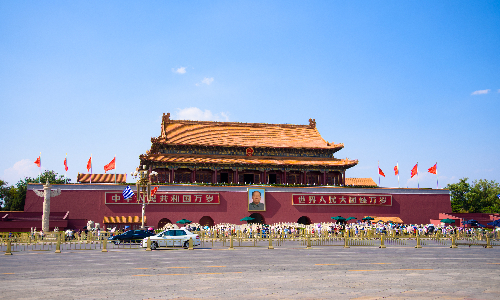
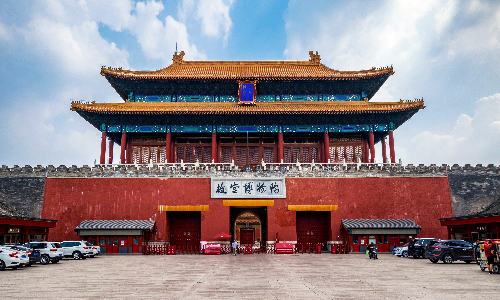
After breakfast, your guide will drive you to Ming Tombs, a complex of tombs peculiar to emperors of the Ming Dynasty (1368-1644). Ming Tombs are about 43 kilometers northeast of the Beijing city area, and it is estimated that you will take a 36-minute car journey to get there. Situated in the foothills of the Tianshou Mountain in Changping District of Beijing, Ming Tombs cover a total area of more than 120 square kilometers. Among the 16 emperors of the Ming Dynasty, 13 of them together with their empresses, princes, princesses, and a few servants rest here in peace. A famous one of the Ming Tombs is Chang Tomb, which belongs to Yongle Emperor, the third emperor of the Ming Empire. You may wonder what the word “Chang” means as it seems that “Chang” is irrelevant to the name of its owner. In fact, there are two meanings behind the word “Chang”. Firstly, “Chang” bears the meaning of “seniority”. Because Yongle Emperor was the first one to move the capital of the Ming Empire from Nanjing (in eastern China) to Beijing (in northern China). In addition, the powerful Yongle Emperor also commissioned the building of the unparalleled Forbidden City. Secondly, the very word also means “long-lasting”, which reflects the Yongle Emperor’s wish for the eternal reign of the Ming Empire.
After lunch, you will head to Badaling Great Wall, about 40 minutes’ drive north-west of Ming tombs. Many people may believe that the Great wall is the name of a specific attraction, which is actually not the case. Since the first great wall had been built during the Qin Dynasty (221BC-207BC), the great wall became a popular means by many emperors to ward off invasions from the nomads in the north. Built in the Ming Dynasty (1368-1644), Badaling Great Wall is the best-preserved and the most-visited one of all great walls, boasting a tourable length of 3741 meters. When you stand on the majestic Badaling Great Wall surrounded by mountains and forests, a question may spring to your mind: how did ancient Chinese manage to carry these heavy stone bricks to this remote place? According to historians, the transport of stone bricks took place in the winter, during which the smart Chinese ancients would pour a lot of water on the road surface a few days beforehand. In this case, a thick, smooth layer of ice, on which workers could push these cumbersome stone bricks onto the construction sites, came into being.
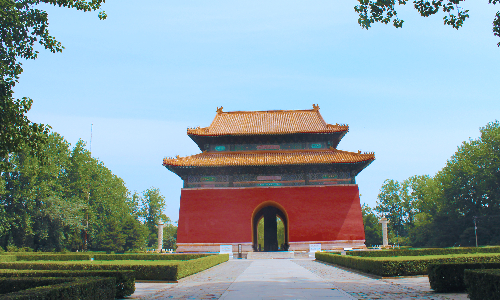
 Guiyang
Guiyang After breakfast, you will pay a visit to your last destination in Beijing, the Temple of Heaven. As a complex of religious buildings exclusive to the royal family, the Temple of Heaven was completed during the Ming Dynasty (1368-1644), covering a total area of approximately 2,730,000 square meters, about 382 times the size of a football field. Temple of Heaven is mainly made up of the Hall of Prayer for Good Harvests and the Circular Mound Altar. On each January 15th in the Chinese lunar calendar, the Emperor would visit the Hall of Prayer for Good Harvests and hold a grand worshiping ceremony praying for a bumper harvest. The Hall of Prayer for Good Harvests is built on a three-level marble stone base, which is 6 meters tall and is surrounded by stone balusters. Inside, the magnificent triple-gabled circular hall is composed of a gilded top, 28 red columns, and numerous blue tiles. The golden top symbolizes the supremacy of royalty because gold used to be the color exclusive to the Emperor. And the blue tiles represent the symbol of the sky. The 28 red pillars constitute three concentric circles, with 4 in the core, 12 in the middle, and another 12 in the outermost layer. The 4 columns in the core represent the four seasons; the 12 in the middle symbolize the 12 months; the 12 in the outermost layer refer to the 12 Chinese hours (each Chinese hour is equal to 2 hours).
After the completion of your visit to the Temple of Heaven, you will be escorted to the airport, where you will take the estimated flight CZ6188 15:15/18:15 to Guiyang of Guizhou Province in southwestern China. Upon arrival, your Guiyang guide will be waiting for you at the arrival hall. You will be escorted to your hotel in Guiyang.
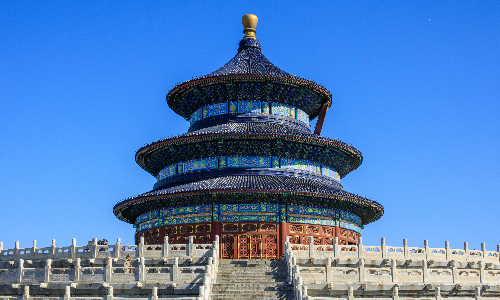
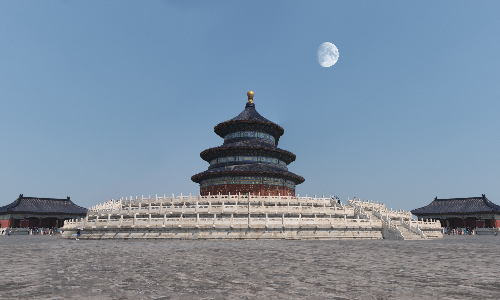
 Anshun
Anshun Guiyang
Guiyang After breakfast, your guide will drive you to Huangguoshu Waterfall, which is about 140 kilometers southeast of the Guiyang city area. It is estimated that you will spend 2 hours in the car. During this period, you are welcome to ask your guide whatever you want to learn about Huangguoshu Waterfall and enjoy some beautiful views outside the car window. Huangguoshu Waterfall represents the largest waterfall in Asia, boasting a height of 77.8 meters and a width of 101 meters. Different from conventional waterfalls, Huangguoshu Waterfall is a waterfall cluster composed of 18 smaller ones. And if you visit here in summer or on a sunny day, you will see the spectacular view of rainbows. The milky waterfall cluster joined by rainbows with a riot of colors will constitute an unworldly picture. So you are suggested to post some of the pictures you take here on your Facebook, these impressive pictures will surely win a lot of likes from your classmates. Besides, there is also a story circulating around the nearby villages. A long time ago, when Huangguoshu Waterfall was still anonymous, there was an old couple living near the very waterfall. The old couple spent most of their life growing tangerine trees behind their small cabin for a living. One day, they found an unusually huge tangerine on one of their trees, which was about the size of a football. The news about the enormous tangerine spread swiftly. A few days later, a mysterious man visited the old couple and offered 50 liang silver (about US$1450) for this rare tangerine. Surprised and confused, the old husband declined, saying that the tangerine was to be used as seeds. The man smiled, raising his offer to 10,000 liang silver (about US$290,000), which promised a decent retirement for the couple. The old wife agreed without hesitation and held tightly the man’s hands for fear that he would change his mind and leave. Instead of asking the couple to pick the tangerine from the tree at once, the man asked the old couple to do it 100 days later. Otherwise, he would not pay for it. During the next 99 days, the couple put everything aside, including taking care of other tangerine trees, to make certain that the “10000 liang silver” was well-tended. On the last day, however, the tangerine, which had grown into the size of a car tire, was so ripe that it seemed to fall at any moment. As a result, the couple picked the tangerine one day in advance in case that the tangerine would fall and break. On the next day, their buyer came to their cabin in the early morning and took the tangerine away. A few days later, words came that the man who had bought their tangerine drown under the waterfall. It was said that the tangerine was the key to a treasure hidden behind the waterfall, and it could stop the torrential water from flowing for some time so that the treasure could be taken away. Maybe, the one day that was short, which may undercut the magic of the huge tangerine, was responsible for the man’s drowning.
After lunch, you will take a stroll in Tianlong Old Town, a popular attraction located deep in the mountainous area in western Guizhou Province. Tianlong Old Town can be traced back to the Ming Dynasty (1368-1644), when Hongwu Emperor (the founding emperor of the Ming Empire) built a number of castles in southwestern China to step up his military presence. People in this ancient town are all descendants of the Ming soldiers stationing here, and they have been practicing the old ways of living for more than 600 years. Notably, the architecture, people’s accent, and clothes here are literally copies from those of the Ming Dynasty. When you walk into Tianlong Old Town, you will feel that you are surrounded by a sea of stones. The stationing soldiers of Tianlong Old Town, to some extent, brought the usages of the stone into full play. The residences are stone-piled; the tiles of the roofs are made up of stones; even the roads are paved with stones of various shapes.
After your visit to Tianlong Old Town, your guide will drive you back to your hotel in Guiyang, where you are suggested to have a good rest in preparation for your tour tomorrow.
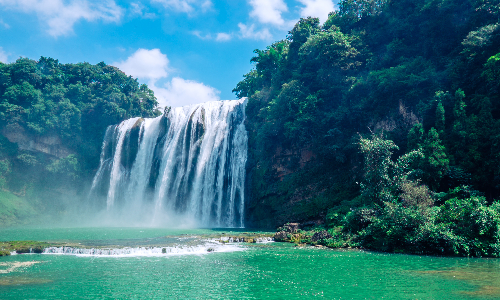
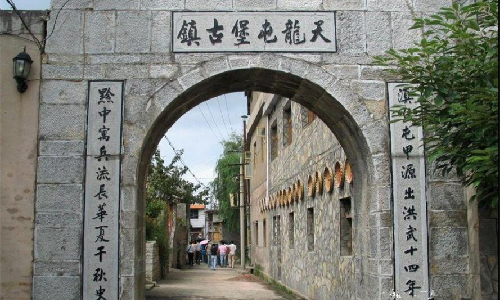
 Kaili
Kaili After breakfast, your guide will drive you to Langde Miao Village in Kaili City in southeastern Guizhou Province, which is about 210 kilometers east of the Guiyang city area. It is estimated that your car journey will take you 3 hours. When you get there, it will be lunchtime and your guide will take you for a lunch in the Langde Miao Village.
After lunch, you will explore the village steeped in Miao (one of the 56 ethnic groups of China) style. As a Miao Village with about 100 households, Langde Miao Village distinguishes itself from other conventional Chinese villages by its stilt houses, Miao dances, and exquisite long dresses. Nestling among the mountains, Langde Miao Village faces a lucid stream, which provides the villagers with water for daily use. When you walk into the village, you will be welcomed by these hospitable villagers in traditional Miao dresses singing beautiful songs and serving aromatic wines. Interestingly, people in Langde Miao Village welcome their guests to their village by stopping them more than once. The more times they stop you, the more welcomed you are. So if you are stopped by these kind villagers, please do not take this as an offensive behavior but embrace this distinctive welcoming ceremony. After the activities, you are free to take a stroll in the village. Every time you pass by a stilt house, you will be greeted with a warm welcome to the inside, where you can have a close look at the inside environment of the Miao residence.
After waving goodbye to those hospitable Miao villagers, your guide will drive you to your hotel in Guiyang, where you can enjoy some private hours and have a good rest.
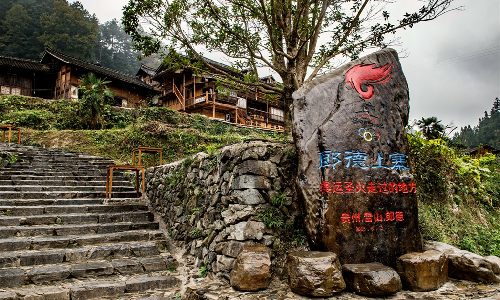
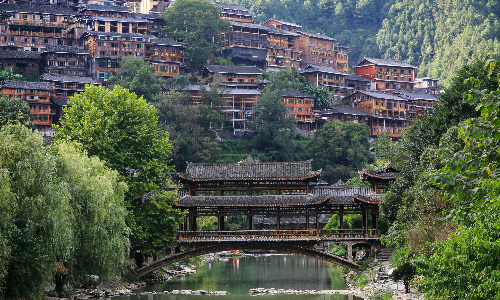
After breakfast, your guide will drive you to Shiqiao Village, an ancient paper-making technique scenic area that is about 200 kilometers east of the Guiyang city area. It is estimated that it will take you 3 hours to get there. Shiqiao Village is one of the most must-visit destinations in your China Student Tour, the ancient village attracts hordes of visitors from home and abroad each year with its ancient paper-making technique. It is said that the village started to make paper as early as the Tang Dynasty (618-907), which is about 1,400 years from now. Apart from the conventional white paper, the village also boasts unique techniques of making paper of other colors. Everybody in this village is capable of making paper. The general process of paper-making in Shiqiao Village is not complicated, including pulping, compressing, and drying. Notably, the places that they choose to produce paper is special, with one under a cliff and the other in a cave deep in the mountains. Inside the cave, there is a stream running out. According to the experts, the alkalescent water makes sure that the paper made in the cave can be preserved for as long as 1,500 years. Therefore, Shiqiao Village is designated as the paper supplier for the Chinese national library and national museum. The paper from Shiqiao Village will be used to restore cultural relics. At the paper-making plant under the cliff, modern technologies like an electronic blender are also adopted to make the ancient paper-making process less tiring. If you take interest in this interesting practice, there will also be an optional activity for you. You can use the tools they provide to make some paper yourself under the guidance of the villagers.
After lunch, your guide will escort you to your hotel in Guiyang, where you are suggested to take a walk around the neighborhood as you will wave China goodbye tomorrow.
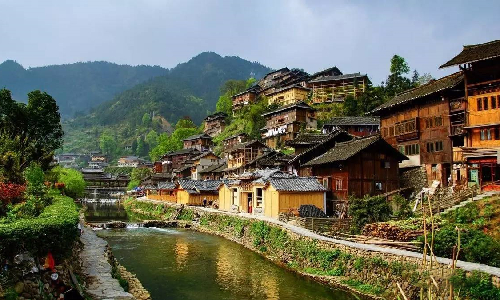
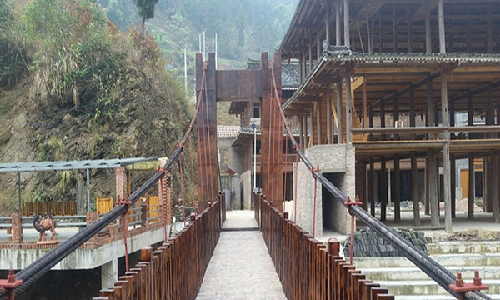
After breakfast, your guide will remind you to pack up your belongings and help you check out. Then you will be escorted to the airport, where you will take a flight home with happy travel experiences in China etch on your memory.
Author: Zhou Yuxin
| City | Five Star hotel list | Four Star hotel list |
|---|---|---|
| Beijing | Sunworld Dynasty Hotel Beijing Wangfujing | Sunworld Hotel Wangfujing |
| Guiyang | Sofitel Guiyang Hunter | Holiday Inn Guiyang City Center |
 |
![]() About your child or infant, please contact us for a discounted price.
About your child or infant, please contact us for a discounted price.



We started with a few days in Beijing & ended in Shanghai, from where we visited the Forbidden City and Great Wall. In between we visited Terra Cotta Warriors Museum, Panda Base, Shanghai Disneyland.

We had a wonderful holiday in China which will remain long in the memory. China is a breathtakingly beautiful country full of splendid temples and palaces, mountains and rivers, peaceful rural scenes and bustling shopping streets.
 QUICK ENQUIRY
QUICK ENQUIRY